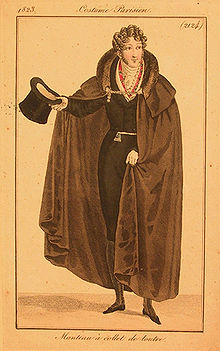思高本
40那願與你爭訟,拿你的內衣的,你連外衣也讓給他。
29有人打你的面頰,也把另一面轉給他;有人拿去你的外衣,也不要阻擋他拿你的內衣。
---
The Traveller - De Reiziger, 1655 – 1660. Frans Hals (1582/1583–1666)
Frans Hals Museum. Oil . 35 x 26 cm.
Portrait of a man, painted wet-in-wet, and based on its small size and on his travelling cloak labelled The Traveller.
|
A cloak is a type of loose garment that is worn over indoor clothing and serves the same purpose as an overcoat; it protects the wearer from the cold, rain or wind for example, or it may form part of a fashionable outfit or uniform. Cloaks have been used by myriad historic societies; many climates favor wearing a full-body garment which is easily removed and does not constrain the wearer with sleeves. Over time cloak designs have been changed to match fashion and available textiles.
Cloaks generally fasten at the neck or over the shoulder, vary in length, from hip all the way down to the ankle, mid-calf being the normal length. They may have an attached hood and may cover and fasten down the front, in which case they have holes or slits for the hands to pass through. However, cloaks are almost always sleeveless.
Contents
Etymology[edit]
The word cloak comes from Old North French cloque (Old French cloche, cloke) meaning "travelling cloak", from Medieval Latin clocca "travelers' cape," literally "a bell," so called from the garment's bell-like shape. Thus the word is related to the word clock.[1]
History[edit]
Ancient Greeks and Romans were known to wear cloaks. Greek men and women wore the himation, from the Archaic through the Hellenistic periods (c. 750-30 BC).[2] Romans would later wear the Greek-styled cloak, the pallium. The pallium was quadrangular, shaped like a square,[3] and sat on the shoulders, not unlike the himation.
Romans of the Republic would wear the toga as a formal display of their citizenship. It was denied to foreigners[4] and was worn by magistrates on all occasions as a badge of office. The toga was claimed to have originated with Numa Pompilius, the second king of Rome.[5]



沒有留言:
張貼留言